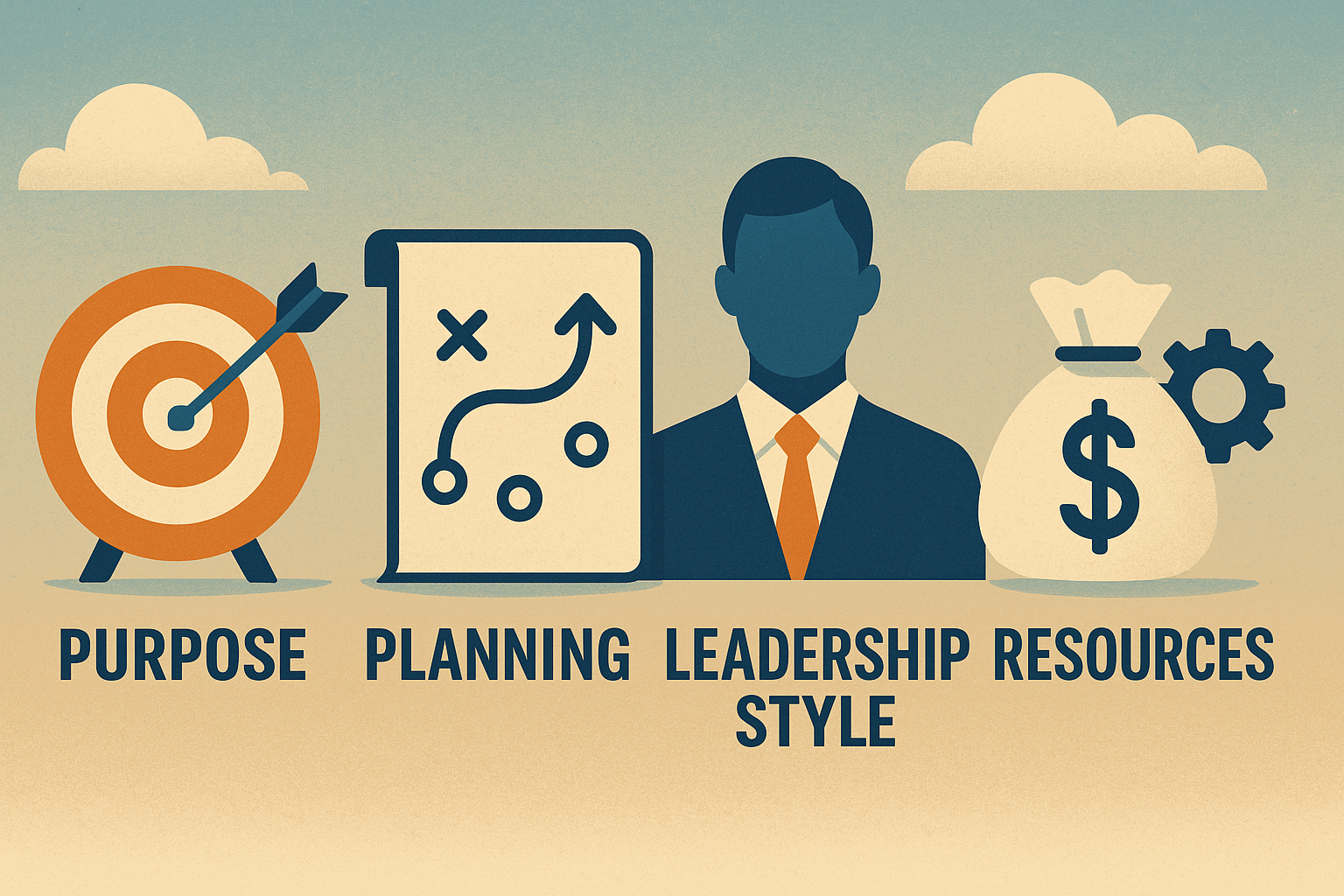By Mark Caddy
The Planning Paradox: Plans are worthless, yet planning is everything
In this article i'm going to describe what leaders need to consider when creating a good plan, specifically:
- your leadership style
- your purpose
- resources available
Planning is essentially figuring out where you are, where you want to be and what the journey to get there will feel like, with just enough detail to inform strategic thinking and not get bogged down in details that will likely be inaccurate later.
In our fast-moving world, planning can feel outdated and redundant with phases like 'We don't plan, we're agile' being popular, fraught with danger and ultimately... wrong, causing some to ask why bother at all?. Too often you're never where you thought you would be, conditions are nothing like the original forecast and the way forwards looks very different to the one you set out on. Hence it’s understandable why some might say “why bother?”. We bother because whilst plans quickly become useless, planning is everything.
I'm reminded of my grandfather and what he had to contest with as a famous north sea skipper in the 60's. He and his crew would set sail for as much as a month at a time. They'd review their charts and weather forecasts before leaving harbour with the purpose of filling their hold with fish. Dispite having a course planned to where fish were recently known to be, fish have a habit of swimming off somewhere else and as such the course has to be able to adapt and change regularly to take account of that, not to mention shifting winds and tides. Sometimes their journey would change so much they'd stop off in harbours or even countries they didnt originally plan to, all in their pursuit of filling the hold with fish. Yes, their plans changed, yet in the planning they'd prepared for probabilities like this. They were equipped with charts for all the areas they might sail into, had sufficient supplies and their passports stowed just in case. The role of a business leaders is not dissimilar.
What's important is not the quality of your plan, but how you planned and for what outcome.
The plan is your compass and must keep pointing towards your north star even when you cannot see the sky above you.
What's your leadership style when planning?
A rigid plan will become a liability, an overly lax plan will lead to delays and low value side quests. The key, then, is to have a planning approach that is responsive to uncertainty and grounded in your leadership style and constraints. Your style will impact the type of plans you produce, or not, so recognising what kind of planner you is key. Do you crave structure, follow trends or drive out of instinct? Knowing your own style is the first step to building a plan that fits how you naturally work and where you want to end up. Here are several popular planning archeatypes.
The watch out for here, is that your own natural style may be to pick an approach that is not a good fit for the type of journey you're planning.
Five Planning Archetypes
1. The Waterfall Planner
Best for: Stable, regulated environments or high-complexity projects with predictable steps.
Not suited for: Rapidly changing markets or early-stage ventures.
Watch out for: Inflexibility. Plans can become obsolete quickly and difficult to adapt mid-course.
2. The Agile Navigator
Best for: Fast-moving teams, iterative development, and environments that reward experimentation.
Not suited for: Ventures that require rigid governance or long-term regulatory visibility.
Watch out for: Losing strategic coherence. Iteration without direction can become noise and result in bad outcomes.
3. The Horizon Scanner
Best for: Strategic thinkers navigating uncertainty, emerging markets, or cross-sector shifts.
Not suited for: Teams needing immediate execution or clarity on short-term goals.
Watch out for: Overthinking, analysis paralysis or insufficient bias to act.
4. The Opportunity Surfer
Best for: Early-stage ventures, trend-led innovations, or businesses exploring relevance in real time.
Not suited for: Missions that require precision, structure, or long-term planning.
Watch out for: getting easily distracted, chasing shiny ideas without filtering them against strategy.
5. The Optimistic Explorer
Best for: Vision-led journeys, founder-driven ideas, or creative missions that defy linear paths.
Not suited for: Complex operational scaling or environments that demand clear forecasts.
Watch out for: Getting lost or worse, disappearing without trace. Can easily drift off course and run out of resources not having fulfilled your purpose.
What's the purpose of your plan?
Every journey is shaped by what you’re aiming to achieve. Some ventures need predictability. Others demand discovery. Your planning style should reflect:
- What’s at stake and why?
- How fast must you move and how far?
- What’s your ultimate goal and how will you know you’ve got there?
As a guide, here are a few common types of purpose and how they influence planning:
1. Risk Mitigation
Best for: Heavily regulated industries, mission-critical infrastructure, public sector transformation.
Not suited for: Rapid prototyping, untested business models.
Watch out for: Over-cautiousness leading to slow momentum and missed opportunities.
2. Market Expansion
Best for: Scaling proven products into new geographies or segments.
Not suited for: High-risk product development or uncertain problem spaces.
Watch out for: Assuming new markets behave the same as your current one.
3. Innovation and Discovery
Best for: New product launches, early-stage ventures, category creation.
Not suited for: Projects with strict delivery requirements or conservative stakeholders.
Watch out for: Getting stuck in idea cycles without testing or delivering.
4. Operational Excellence
Best for: Driving internal efficiency, performance gains, or service quality.
Not suited for: Disruptive change or uncharted environments.
Watch out for: Losing sight of customer value while optimising internal systems.
5. Capability Overhaul
Best for: Building new environments, or transforming existing ones whilst keeping all the lights on throughout.
Not suited for: Fast turnarounds or environments lacking leadership sponsorship.
Watch out for: No clarity of vision of what success looks like, inconsistent follow-through or disengaged leadership and stakeholders.
What resources are available?
Resources are the scaffolding of your plan, and the three critical factors are budget, people, and expertise. All three are important, but budget ultimately beats everything. As Klaas Ardinois says when talking about fund raising for startups
"Cash in the bank, and the optionality from that is the most important thing right now." – Klaas Ardinois
So whilst all elements are important, ultimately your budget will inform your planning approach else your planning approach will burn through your budget.
1. Budget
Essential for: Sustaining timelines, funding experiments, unlocking optionality, absorbing setbacks.
Watch out for: Burn rate creep. Overconfidence in runway length or delays in revenue can quickly derail execution.
2. People
Essential for: Executing the plan, adapting in real-time, holding accountability. A capable team can compensate for other shortfalls.
Watch out for: Talent gaps in leadership, delivery, or culture-fit. Misalignment here leads to confusion, drag, or internal resistance.
3. Expertise
Essential for: Solving hard problems, bringing innovation to life, delivering quality outcomes. Deep domain expertise can reduce risk and increase speed.
Watch out for: Overestimating what your current team can do or underestimating the need for specialists.
I can already hear some of you saying "what about tooling and AI?". Yes they play a strong part but if you don't have the budget, people or expertise to utilise them you're high and dry. Stay focused on what's critical
Do NOT overlook financial planning
Every plan needs a coherent financial model and it's not a constraint it’s a compass. Countless transformations have run aground during challenging times and in the iron triangle of time, cost and quality it is budget that will ultimately dictate where you finally end.
Even with the right people and expertise, budget determines where you end. It dictates how long you can iterate for, how far you can explore, how fast you can move, and how robust your fallback plans are.
Good planning always considers the full resource picture, but the smartest plans are the ones that align ambition to financial reality. Budget is the throttle that burns through your bank account. Now how far it takes you, when to use tactically and how to stretch it strategically.
Figuring out your planning approach
When bootstrapping you’ll need to plan like an Agile Navigator or an Explorer: small teams, short cycles, minimal waste. When you're in grow fast mode and have secured strong funding, you will have more options: longer discovery phases, more parallel initiatives and deeper experiments.
Three examples of combinations that tend to work well together are:
1. The Lean Visionary
- Style: Optimistic Explorer
- Purpose: Innovation and Discovery
- Resources: Limited budget, tight-knit team, strong domain knowledge
This works well for early-stage founders with a bold idea but little cash. Their intuitive style and exploratory mindset allow them to take risks in short bursts, stay focused on learning, and adapt quickly when something doesn’t stick.
2. The Scaling Strategist
- Style: Horizon Scanner
- Purpose: Market Expansion
- Resources: Healthy budget, experienced leadership, good customer insight
Perfect for organisations that have already found product-market fit and want to grow into new verticals or regions. This group can afford to take a step back, scan for strategic options, and build optionality into their plan while moving decisively.
3. The Regulated Reformer
- Style: Waterfall Planner
- Purpose: Risk Mitigation
- Resources: Large budget, deeply skilled team, complex oversight requirements
Ideal for initiatives where stability, documentation, and compliance matter most, think public sector transformations or large-scale infrastructure upgrades. This combination prioritises structured execution and minimises ambiguity, though it needs extra checks to remain adaptive over time.
Relevance is everything and all approaches are relevant in the right context and all are wrong in the wrong context so make sure you know your situation and constant review.
A tightly defined mission with regulatory pressure may require a Waterfall or Horizon approach. A venture exploring unproven markets may benefit most from the mindset of a Navigator or Explorer. Aligning your leadership planning style to your purpose will reduce friction, unlock momentum and ultimately reduce risk.
Planning isn’t about certainty, it’s about confidence towards an outcome. Progress over perfection is fine but being busy does not necessarily equate to fulfilling any of your purpose, just that busy doing something…
THE BIG TAKE AWAY
The most effective plan is not the most detailed, ambitious or simple. It's the one that fits your style, purpose and resources.
Start with self-awareness, match that to your purpose and keep one eye on your wallet, always.


